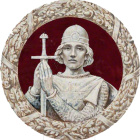Palace Park - Chinese Theater
by Christine Martin
Catherine the Great wanted to create areas of fascination as well as areas of recreation in her park at Tsarskoe Selo. Increasingly known as an admirer of Neoclassicism, she decided she would introduce a less serious note to her surroundings. She wanted to construct a world of wonder. To “capture by caprice” this was how she described her wish. Her decision to explore an oriental theme was to grow into an entire “Chinese” complex – a little Chinatown.
In 1770 the Italian architect, Antonio Rinaldi, was invited to present plans for such an ensemble. He proposed the creation of a “Chinese” village with houses, theatre and pavilions. These plans were not realized. It was 1780 before work began on the “Chinese” village. This was now created and developed by the Scottish architect, Charles Cameron. The design of the “Chinese” theatre, however, was entrusted to the Russian father and son architects, Vasily and Peter Neyelov. Their final result was an adaptation of Rinaldi’s original plan.
The exterior of the Chinese Theatre was simple. Its broad roof turned up at the corners in the characteristic Chinese manner The only embellishment in the white plastered walls were its deep ornamental cornice, door and window surrounds. The interior belied the plain exterior. It was sumptuous. Designed and decorated with the vivid shapes and colours of Chinese ornament it was highlighted with liberal applications of silver and gold leaf.
As well as the auditorium, which could seat five hundred people, there was the stage and Imperial Boxes, an Entrance hallway and grand staircase leading to a pair of drawing rooms. The Red Drawing Room and the Blue Drawing Rooms’ names reflect the colour of their soft furnishings. In these rooms guests were received and suppers served. Decorated and furnished in chinoiserie they were kept cozy with open fires blazing in fireplaces whose surrounds were fashioned in porcelain. The Imperial Box was directly accessed from the Red Drawing Room.
The most outstanding decoration was reserved for the Imperial Box and for the boxes of the Grand Dukes positioned on each side of it. 16th Century black lacquer panels lined their walls, the furniture was fashioned with Chinese motifs, porcelain chandeliers hung from the ceilings and a dangle of gilded bells was slung along the back wall. (check paper lanterns)
The first performance took place in the Chinese Theatre on June the 13th 1779 in the presence of Catherine the Great. It was an opera by the Italian composer, Giovanni Paizello entitled ‘Dmitri Artaxerx’. Paizello’s work was a success, for only two months later, on August the 16th of the same year, his opera the ‘Chinese Idol’ was staged at the Theatre.
After the death of Catherine the Great, the cultural life Tsarskoe Selo and of the Chinese Theatre became moribund. Only occasionally was the Theatre used One such occasion took place in 1830 when Emperor Nicholas I attended a performance of Rossini’s ‘The Barber of Seville’.
It was not until the closing years of the 19th century that new life was breathed into the Chinese Theatre. In 1893 Leo Tolstoy’s play ‘The Fruits of Enlightenment’ was premiered there. The following year Sophecles Oedipus Rex was staged.
At the beginning of the 20th century, during the reign of Nicholas II, a long-awaited revival was witnessed in the use of the Chinese Theatre. It became a popular venue for staging Imperial Galas and Command Performances. The Empress, Alexandra Feodorovna was reluctant to visit St Petersburg. In part this was due her relentless health problems, but another reason lay in the imperial couple’s constant awareness and fear of assassination.
Electricity was introduced to the Chinese Theatre in 1902 in preparation for the State visit of the French President Loubet. One of the highlights of his visit was a Command Performance by members of the His Majesty’s Mariisnky Theatre which was to be held in the Theatre.
Tamara Karsavina was one of the most beautiful prima ballerinas every to grace the Russian stage. She had recently graduated from the Imperial Ballet School when ‘…The future smiled on me again. An overwhelming luck fell to my lot. A gala performance was being prepared for the expected visit of the French President Loubet. The best artists were selected for this performance. …the ballet given was Lac des Cygnes.
‘The gala performance took place in the Chinese Theatre of Tsarskoe Selo, which stood in the Chinese Village, a graceful whim of Catherine the Great. Built in 1778, the theatre was kept in good repair. It stood among ancient pagoda-like fir trees. Inside, it was of rare charm – lacquer panels ornamenting boxes, red and gold rococo chairs, bronze chandeliers with porcelain flowers – all the precious chinoiserie of the eighteenth century.’
The striking brilliant orange silk curtain decorated with, handpainted, typically Chinese landscape scenes, rose on one of Russia’s greatest contributions to the world of culture, composed by Tchaikovsky, one of Russia’s greatest composers - the ballet Swan Lake.
‘All through the evening there was no applause. The bejewelled audience remained mute, passive as a tableau vivant in the light of innumerable candles. The Imperial Family and Court were present. Every artist afterwards received a present from the Emperor, as was always the case with imperial performances.’
Nicholas IIs cousin, Konstantin Konstantinovich Romanov, a well-known writer and poet, lived nearby at the exquisite palace of Pavlovsk. Using his initials KR as his pseudonym, he was the first person to translate Shakespeare into Russian. By 1901, he had not only translated Hamlet, but he staged and appeared in it himself, in the Chinese Theatre.
KR continued to use of the Chinese Theatre and on the 14th of February 1909, he noted in his diary – “I asked the Emperor about putting on “The Bride” (of Messina) at the Tsarskoe Selo Chinese Theatre.”
On 14th September 1912, Nicholas wrote to KR from his hunting lodge in Poland – “Dear Kostia….. I have been meaning to write to you ever since I read aloud to Alix your play “King of Judea”.
“It made the deepest impression on me – more than once my eyes filled with tears and I had a lump in my throat. I am certain that to see your play on stage and to hear the beautiful paraphrasing of what each of us knows from the Gospels, all this could but produce the most profound effect on the spectator.
It is for this reason that I share the opinion of the Holy Synod that it cannot be publicly staged*. However, the Chinese Theatre of the Hermitage (the theatre in the Winter Palace) could be made available for it, as well as the singers who participate in the “Ismailovsky celebrations.” (One of Russia’s elite regiments).
*The play was about the crucifixion of Christ and Nicholas was worried that it might lead to anti-Semitic feelings if shown in public.
In 1908, Nicholas II commissioned his court architect, Danini, to institute major repairs and alterations to the Chinese Theatre. As well as creating a magnificent marble staircase, he replaced the antiquated 18th century stage equipment with the very latest in stage technology making it possible to present the new, home-grown, large-scale operas and ballets. Many of the sets were mapped by the magic hand of Leon Bakst. More prosaically, a new heating system was installed but this meant the Chinese Theatre could now be used all year round.
Sadly these innovations were not to be enjoyed for long. Performances stopped with the outbreak of World War I in 1914. Romanov associations with the Chinese Theatre ended forever with the Revolutions of 1917 and 1918.
Today the Chinese Theatre lies in ruins. It was on the 15th of September 1941,that it became the first victim of a Nazi bomb - even before the occupation of Pushkin (formerly Tsarskoe Selo).
Lost forever is this gem of chinoiserie. Some older residents of Pushkin recall how, prior to 1941 and the Nazi occupation, they were allowed the rare honour of peeking inside. Today they recall it was “Like looking inside a magical musical box.”









 Imperial Bedroom
Imperial Bedroom Portrait Hall
Portrait Hall Mauve Room
Mauve Room Maple Room
Maple Room Aleksey's Bedroom
Aleksey's Bedroom Nicholas's Study
Nicholas's Study Aleksey's Playroom
Aleksey's Playroom Formal Reception
Formal Reception Balcony View
Balcony View Aleksey- Balcony
Aleksey- Balcony Children-Mauve
Children-Mauve Nicholas's Bathroom
Nicholas's Bathroom Alexandra- Mauve
Alexandra- Mauve Nicholas's Reception
Nicholas's Reception Tsarskoe Selo Map
Tsarskoe Selo Map